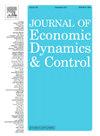央行内生反应下的货币政策传导
IF 2.3
3区 经济学
Q2 ECONOMICS
引用次数: 0
摘要
在双代理新凯恩斯模型中,我们研究了货币政策创新的传导如何受到中央银行对宏观经济总量的内生反应的影响。我们关注货币政策的立场和经济中储蓄者的比例如何影响传导。研究表明,当间接实际利率效应超过间接收入效应时,创新的间接效应为负。间接实际利率效应的相对大小随着储蓄者比例和央行应对力度的增加而增加,随着创新的广度而减小。本文章由计算机程序翻译,如有差异,请以英文原文为准。
Monetary policy transmission with endogenous central bank responses in TANK
We study how the transmission of monetary policy innovations is affected by the endogenous response of the central bank to macroeconomic aggregates in a two-agent New Keynesian model. We focus on how the stance of monetary policy and the fraction of savers in the economy affect transmission. We show that the indirect effect of an innovation is negative when the indirect real rate effect exceeds the indirect income effect. The relative magnitude of the indirect real rate effect increases with the share of savers and the strength of the central bank's response and decreases with the horizon of the innovation.
求助全文
通过发布文献求助,成功后即可免费获取论文全文。
去求助
来源期刊

Journal of Economic Dynamics & Control
ECONOMICS-
CiteScore
3.10
自引率
10.50%
发文量
199
期刊介绍:
The journal provides an outlet for publication of research concerning all theoretical and empirical aspects of economic dynamics and control as well as the development and use of computational methods in economics and finance. Contributions regarding computational methods may include, but are not restricted to, artificial intelligence, databases, decision support systems, genetic algorithms, modelling languages, neural networks, numerical algorithms for optimization, control and equilibria, parallel computing and qualitative reasoning.
 求助内容:
求助内容: 应助结果提醒方式:
应助结果提醒方式:


